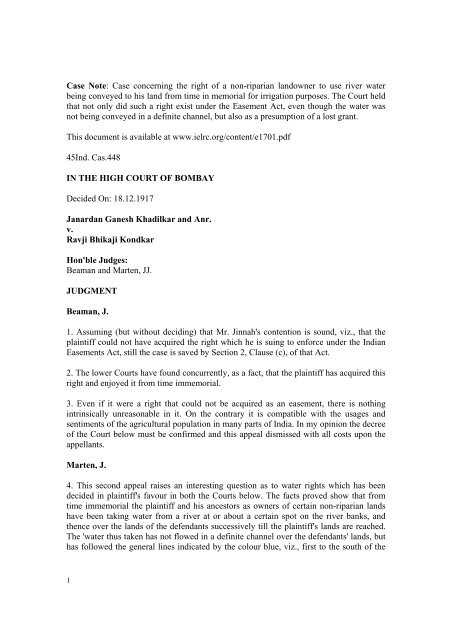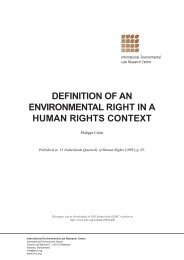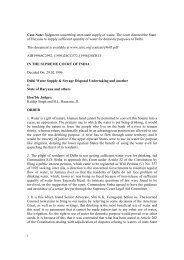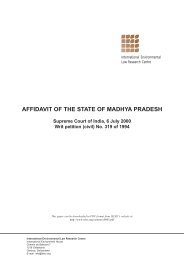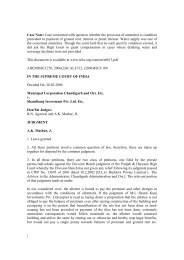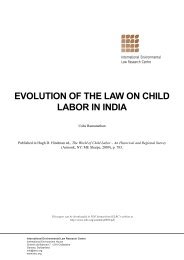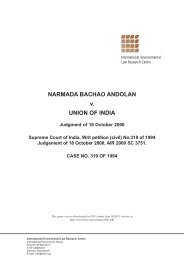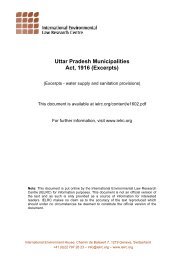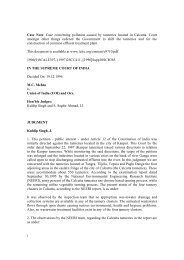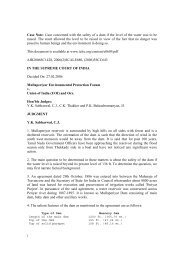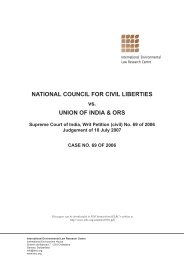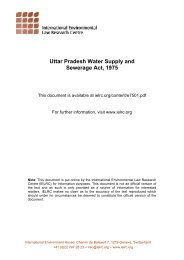IELRC.ORG - Janardan Ganesh Khadilkar v. Ravi Bhikaji Kondkar
IELRC.ORG - Janardan Ganesh Khadilkar v. Ravi Bhikaji Kondkar
IELRC.ORG - Janardan Ganesh Khadilkar v. Ravi Bhikaji Kondkar
- No tags were found...
Create successful ePaper yourself
Turn your PDF publications into a flip-book with our unique Google optimized e-Paper software.
Case Note: Case concerning the right of a non-riparian landowner to use river waterbeing conveyed to his land from time in memorial for irrigation purposes. The Court heldthat not only did such a right exist under the Easement Act, even though the water wasnot being conveyed in a definite channel, but also as a presumption of a lost grant.This document is available at www.ielrc.org/content/e1701.pdf45Ind. Cas.448IN THE HIGH COURT OF BOMBAYDecided On: 18.12.1917<strong>Janardan</strong> <strong>Ganesh</strong> <strong>Khadilkar</strong> and Anr.v.Ravji <strong>Bhikaji</strong> <strong>Kondkar</strong>Hon'ble Judges:Beaman and Marten, JJ.JUDGMENTBeaman, J.1. Assuming (but without deciding) that Mr. Jinnah's contention is sound, viz., that theplaintiff could not have acquired the right which he is suing to enforce under the IndianEasements Act, still the case is saved by Section 2, Clause (c), of that Act.2. The lower Courts have found concurrently, as a fact, that the plaintiff has acquired thisright and enjoyed it from time immemorial.3. Even if it were a right that could not be acquired as an easement, there is nothingintrinsically unreasonable in it. On the contrary it is compatible with the usages andsentiments of the agricultural population in many parts of India. In my opinion the decreeof the Court below must be confirmed and this appeal dismissed with all costs upon theappellants.Marten, J.4. This second appeal raises an interesting question as to water rights which has beendecided in plaintiff's favour in both the Courts below. The facts proved show that fromtime immemorial the plaintiff and his ancestors as owners of certain non-riparian landshave been taking water from a river at or about a certain spot on the river banks, andthence over the lands of the defendants successively till the plaintiff's lands are reached.The 'water thus taken has not flowed in a definite channel over the defendants' lands, buthas followed the general lines indicated by the colour blue, viz., first to the south of the1
westernmost embankment coloured red on the map in the suit, and then bifurcatingalmost at right angles east and west. The map is not so helpful as it might be. It containsno scale and no compass bearings, and only shows a portion of the river, viz., that to theeast of the embankment I have mentioned. It is on the site of this embankment that thewater has hitherto been taken. The embankment itself was only built some eighteen yearsago but the findings are that the plaintiff then pierced this embankment so as to admit ofthe water flowing as before, and that the pipe he subsequently placed for that purpose wasa hollowed palm tree which he subsequently renewed. It was then that the defendantsobstructed the pipe and the flow of water for the first time, and consequently this actionwas brought. The embankment I have referred to is called "the dam in dispute" in theCourt of first instance, and must not be confused with the dam which from time to timehas been placed by the plaintiff and others in the river bed itself so as to ensure a supplyof water in time of drought or scarcity.5. The technical difficulty here is that the water has been brought not in a defined channelbut has been allowed to spread over and irrigate the defendants' lands first and then theplaintiff's. This indeed appears to be a common method of irrigation in India see VilluriAdinarayana v. Polimera Ramudu 17 Ind. Cas. 648 : 37 M. 304 at p. 306 : 12 M.L.T. 637: 24 M.L.J. 17. It has at any rate been the method adopted for very many years forirrigating the paddy fields in dispute in the present case. Accordingly the contention ofthe defendants that the plaintiff's right, if established, "would tend to the total destructionof the defendants' property" within the meaning of Section 17(a) of; the Indian EasementsAct may be summarily dismissed.6. The defendants' substantial objection is that the right claimed is really one "to surfacewater not flowing in a stream" and hence cannot be acquired as an easement under theIndian Easements Act [see Section 17(c)], nor be the-subject of a presumed lost grant. Inmy judgment that is not really the right which the plaintiff is claiming. He is reallyclaiming the right to take the water from the river without interruption by the defendants,and to have it conveyed over their lands. According to the Court of first instance theplaint alleges that "from the time of his ancestors the plaintiff has been in the habit oftaking the water of that river for irrigating his lands'." The plaint then proceeds to givedetails as to how that water is taken and reaches plaintiff's lands.7. Some difficulty was caused by the fact that a large portion of the embankment inquestion appears to be on land belonging to Government, and not to the defendants asthey alleged, The Collector, however, does not appear to lake any objection, and so far asthe present parties are concerned, I do not know that the point is really very material.Defendant No. 3 is now the Government tenant but has been warned not to obstruct theplaintiff in taking the water.8. If, then, my view of the facts is correct, the claim is to river water and not to meresurface water on the defendants' lands and consequently Section 17(c) does not apply.9. It is no doubt true that the method of conveying that river water over the defendants'lands creates a difficulty, for some is used to irrigate the defendants' lands or may be lost2
y percolation, and on the other hand the volume of general water on the defendants'lands may the affected by rain water falling on their lands or from other like causes. Thismight, however, happen just the same if the water was convened in a definite openchannel. Some of the river water might still be diverted by cross-cuts in that channel onthe defendants' lands. Further, rain water falling on the defendants' lands might easilyincrease the volume of water in the open channel. One may, I think, fairly assume that themethod actually adopted in the present case of conveying this river water for all theseyears is the one best suited to local requirement, and preferable in particular to a definitechannel with cross-cuts. Budhu Handed v. Maliat Mandal 30 C. 1077 and Kensit v. GreatEastern Railway Co. (1884) 27 Ch. D. 122 : 54 L.J. Ch. 19 : 51 L.T. 862 : 32 W.R. 885.are instances of an easement or grant for river water across certain lands.10. But the plaintiff does not necessarily depend on the Indian Easements Act. Section2(c) provides that nothing in that Act is to derogate from any right acquired before thisAct comes into force". Had then the plaintiff or his predecessors in-title acquired anysuch right before the Indian Easements Act came into operation? I think he had. Thedecisions in Ramessur Persad Narain Singh v. Koonj Behary Pattuk 4 C. 633 : 6 I.A. 33 :3 Bar. P.C.J. 866 : 3 Ind. Jur. 179 : 2 Shome L.R. 194 : 2 Ind. Dec. (N.S.) 402 and RajrupKoer v. Abul Hossein 6 C. 394 : 7 C.L.R. 529) 7 I.A. 240 : 4 Shome L.R. 7 : 4 Sar. P.C.J.199 : 3 Suth. P.C.J. 816 : 4 Ind. Jur. 530 : 3 Ind. Dec. (N.S.) 257 (P.C.) show that thepresumption of a lost grant is one which may be made in India as well as in England. Thepresumption arises out of the strong desire of the Courts to find a legal origin for anancient and uninterrupted user. The presumption may be rebutted like otherpresumptions. It also requires certain conditions, and one is that the right could have beenthe subject of a grant. As Lord Selborne puts it in the leading case of Goodman v. SaltashCorporation (1886) 7 A.C. 633 at p. 639 : 52 L.J.Q.B. 193 : 48 L.T. 239 : 31 W.B. 293 :47 J.P. 276: An open and uninterrupted enjoyment from time immemorial under a claimof right seems to me to be all that is necessary for a presumption that it had such an originas would establish the right, if a lawful origin was reasonably possible in law."11. Is then the grant of the right claimed reasonably possible in law? I think it is. It is truethat the plaintiff is a non riparian owner. Presumably, therefore, the riparian owner of theembankment in question could not have made a grant of the river water so as to affect thelower riparian owners, see Ormerod v. Todmorden Joint Stock Mill Co. (1883) 11 Q.B.155 : 52 L.J.Q.B. 445 : 31 W.B. 759 : 47 J.P. 532 and McCartney v. Londonderry andLough Swilley Railway Co. Ltd. (1904) A.C. 301 at p. 315 : 73 L.J.P.C. 73 : 91 L.T. 105: 53 W.R. 385. But the grant would at any rate be good as against such grantor (see samecases), and I assume also against his sequels in title. And the lower riparian owner couldnot complain unless he was injuriously affected in fact. I See Kensit v. Great EasternRailway Co. (1884) 27 Ch. D. 122 : 54 L.J. Ch. 19 : 51 L.T. 862 : 32 W.R. 885. Further,as between himself and the lower riparian owners, the grantor might justify the user by agrant from the lower riparian owner or by, prescription [see McCartney's case (1904)A.C. 301 at p. 315 : 73 L.J.P.C. 73 : 91 L.T. 105 : 53 W.R. 385]. In this very case we finda dam erected in the river bed, and this I suppose could only be justified against lowerriparian owners by grant or prescription. Possibly the non-riparian grantee could not suethe lower riparian owners in his own name [see Ormerod's case (1883) 11 Q.B. 155 : 523
L.J.Q.B. 445 : 31 W.B. 759 : 47 J.P. 532]. Here, however, the defendants or theirpredecessors are either the original grantors of the river water, or else are the grantors ofthe right to have such water conveyed over their land in the way specified. In otherwords, I think it reasonably possible in law that the defendants' predecessors could havegranted the right to convey definite river waters over their lands notwithstanding thatsuch river waters flowed or passed through the defendants' lands in no definite channel.In this respect the case presents a considerable resemblance to that of Villuri Adinarayanav. Polimera Bamudu 17 Ind. Cas. 648 : 37 M. 304 at p. 306 : 12 M.L.T. 637 : 24 M.L.J.17.12. It was suggested that the pleadings in the present case did not permit of thepresumption of a lost grant. The plaint, however, clearly pleads the fact of immemorialuser, and it is this fact which raises the presumption in law. Further, this very point isdealt with in the judgment of the Court of first instance at page 22, line 41. If necessary,therefore, the pleadings should be treated as amended to as to raise this point expressly,and I decide this case on that footing.13. Some objection was made as to the form of the original decree. No objection appearsto have been taken on this head in the lower Appellate Court, and I do not see that it isessential to vary the form of the decree. In effect the injunction is intended to preserve theimmemorial user.14. In my judgment the appeal should be dismissed with costs.Note: This document has been provided online by <strong>IELRC</strong> for the convenience of researchers and otherreaders interested in water law. <strong>IELRC</strong> makes no claim as to the accuracy of the text reproduced whichshould under no circumstances be deemed to constitute the official version of the document.4


